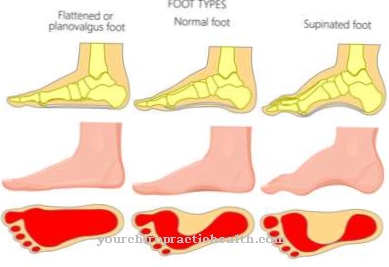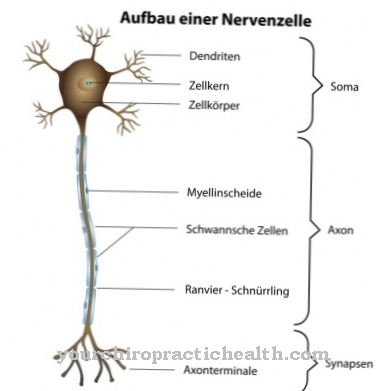Presbyopia, Presbyopia or Presbyopia is the reason that most people aged 45 and over have to buy reading glasses. Presbyopia is understood to be a normal ametropia that is caused by aging.
What is presbyopia?
.jpg)
© GiZGRAPHICS - stock.adobe.com
The Presbyopia In this sense, it does not count directly as ametropia, such as farsightedness, nearsightedness or astigmatism, since it is not the result of a change in the pathological sense.
Presbyopia is a natural consequence of the aging process of the eye in which the lens of the eye loses its elasticity. One's presbyopia doesn't get as bad as the other, but everyone suffers from it at some point.
The lens is no longer able to adapt to objects that are close in front of the eye and thus to see them clearly. This adaptability is also known as accommodation and decreases more and more from the age of 40.
causes
The cause of the Presbyopia is, simply put, age. In the course of the aging process, changes take place in the lens that make it difficult to focus. As the core of the lens hardens, the lens capsule loses its elasticity.
As a result, the lens is no longer able to buckle during accommodation, which is necessary for clear vision. Although this process of presbyopia already occurs in childhood, it only becomes noticeable between 40 and 50 years of age. The lens begins to stiffen from the age of 10.
The process is slow and must have progressed to a certain extent in order to notice the first difficulties in reading.
Symptoms, ailments & signs
The first sign can be a gradual change in arm position when reading the newspaper in the morning. The newspaper reader may also focus more on the lighting conditions than before. The problem is the same: It is more difficult for the viewer to recognize sentences, words and numbers.
These signs can also appear while reading an expiration date in the supermarket or a restaurant menu. The perception of the early symptoms of presbyopia, also called presbyopia or presbyopia, is often ignored at first. The signs become clearer when further disruptive symptoms occur. It can mean that reading is increasingly perceived as exhausting and tiring.
In the area of the forehead and eyes, an uncomfortable, dull feeling of pressure can develop when reading for a long time. Headaches of varying intensity and dizziness may even develop. These phenomena are intensified by the ongoing aging process. Short-distance perceptions are increasingly perceived as blurred and blurred due to the decreasing elasticity of the eye lens.
Muscular tensing and squeezing in the eye area also indicates a possible presbyopia. It is also symptomatic of presbyopia if other people's reading glasses are used on loan because the writing has allegedly become so small. If minor injuries occur unusually frequently during manual work, it can also be due to age-related visual impairment. There are also signs of changes in near vision when using screens.
Diagnosis & course
The diagnosis is made Presbyopia based on an eye test at the ophthalmologist, which is carried out due to a noticeable deterioration in vision. A more specific examination is usually not necessary if presbyopia is determined. The course is, as already mentioned, quite slowly progressing, so that the adaptability of the eye only decreased in the 4th or 5th decade of life to such an extent that it becomes noticeable. From this point on, you basically have to wear reading glasses.
Complications
In normal cases, presbyopia is a normal accompanying symptom that accompanies aging and which can be compensated for by wearing close-range glasses or by eye lasers. Since the near point moves further away from the eye with increasing age, most people suffer from this form of ametropia from around the age of 40.
Complications usually only occur if the ametropia is not compensated for by suitable, individually adapted visual aids, for example reading glasses or workplace glasses. Without glasses, the eye muscles are overstrained and this can lead to tiredness, headaches and a dull feeling of pressure in the forehead or eyes. In addition, eyesight can deteriorate further due to eye strain.
In addition, poor vision at close range can lead to further problems if objects that you have to work with are no longer correctly recognized, which increases the risk of accidents in some professions. If presbyopia is accompanied by opacity of the lens, as in cataracts, surgery must always be performed and an artificial lens inserted.
When should you go to the doctor?
If there is a deterioration in vision in old age, the family doctor or ophthalmologist should be consulted. Problems reading magazines or labels indicate presbyopia, which is best cleared up quickly. Usually it is sufficient to wear a visual aid and to protect your eyes to alleviate the suffering. Older people have a particularly high risk of developing presbyopia.
People who work a lot at a monitor or who come into contact with pollutants at work are also among the risk groups and should consult a doctor if visual problems occur. In addition to the ophthalmologist, an optician and, if necessary, a surgeon must also be called in. If the symptoms get worse, the visual aid must be adjusted. Surgical treatment of the condition is possible if the visual acuity is severely reduced or occurs in connection with external influences. Typical presbyopia is a normal age-related loss of function and can only be corrected to a limited extent.
Treatment & Therapy
_2.jpg)
The can be treated Presbyopia not in the direct sense, but the ametropia can only be corrected by wearing reading glasses.
The lens of the glasses is convex. How strong the glasses have to be depends on how old the wearer is and how far the reading distance is from the eye. The closer something should be in front of the eye, the more strength the glasses must have in presbyopia. If you already have ametropia, i.e. nearsightedness or farsightedness, varifocals can be used to read or work closely with presbyopia.
Contact lenses can also be worn in presbyopia. Anyone who is used to contact lenses due to other ametropia can also choose varifocal contact lenses for correction with preybyopia. If the presbyopia is very pronounced in older people, it can make sense to have an eye operation performed in which your own lens is replaced by an artificial one.
Unfortunately, presbyopia cannot be remedied with lasers, as the cornea is changed during surgery; the lens stiffens in presbyopia and cannot be treated with this method.
You can find your medication here
➔ Medicines for visual disturbances and eye complaintsprevention
Since the Presbyopia is the natural consequence of the aging process of humans and thus also of their eyes, it cannot be specifically prevented. However, an attempt can be made to delay presbyopia by exercising the eyes.
The muscles that are responsible for the accommodation of the eye are strengthened, for example by regularly focusing in the distance and in the vicinity. This exercise can be done several times a day, especially if you are outside. Long periods of sitting in front of the PC or television can negatively affect eyesight. However, it cannot be determined with certainty whether this will slow down presbyopia.
Aftercare
Presbyopia is not a clinical picture in its actual meaning. For this reason, follow-up care in the medical sense is not necessary. The development of presbyopia persists over a long period of time during which some signs of progression can be observed. These include, for example, increasing blurring at close range.
Initially with activities such as reading books, tablets, looking at the clock, later also more distant activities such as reading the newspaper or working on a computer screen. If there is any deterioration, it is advisable to contact the local optician, who can provide a remedy with glasses specially designed for your needs.
But other signs can also indicate that presbyopia has increased again. Headaches, dizziness, and nausea can all indicate this. Basically, it is advisable to have your eyes checked every two to three years, from a certain age also in connection with a medical check-up.
If one or more of the above-mentioned difficulties arise before then, it is advisable to contact an ophthalmologist or optometrist immediately. Correctly adjusted and adapted reading, workplace or varifocal glasses can significantly improve the quality of life.
You can do that yourself
Presbyopia is one of the natural developments in humans. It does not affect every aging person and the intensity is also individual, but it should be understood as a normal part of the human development process.
As part of self-help, the attitude towards natural changes in the organism must be checked and changed as soon as necessary. Otherwise, emotional stress occurs, which contributes to a deterioration in well-being and thus increases the risk of further illnesses.
The eyes should not be exposed to excessive strain. Intense exposure to light or looking into bright sunlight should be avoided. It is advisable to wear privacy protection outdoors when the sun is exposed. Optimized lighting conditions are necessary at all times of the day so that viewing can take place without great effort. Work on screens must be interrupted at regular intervals. The eyes are relieved by breaks and regeneration can take place. Strained or cramped vision is to be avoided. If a headache occurs due to sight, an ophthalmologist should be consulted. Your own behavior has to be optimized so that the inner tension is reduced.
It is advisable to wear glasses for the first age-related loss of sight. The visual acuity must be checked at regular intervals so that changes can be made as quickly as possible.


.jpg)

.jpg)
.jpg)


















.jpg)



